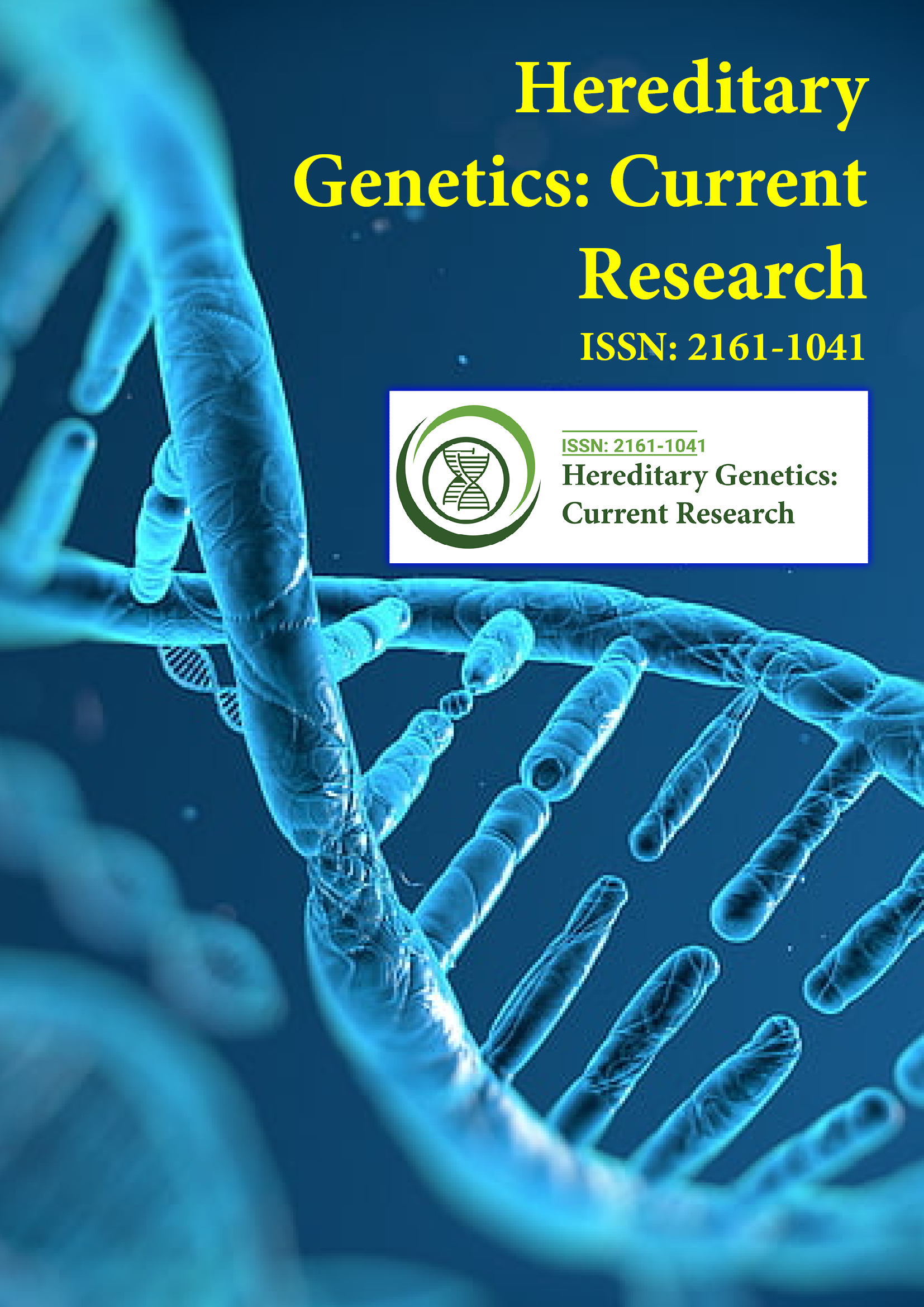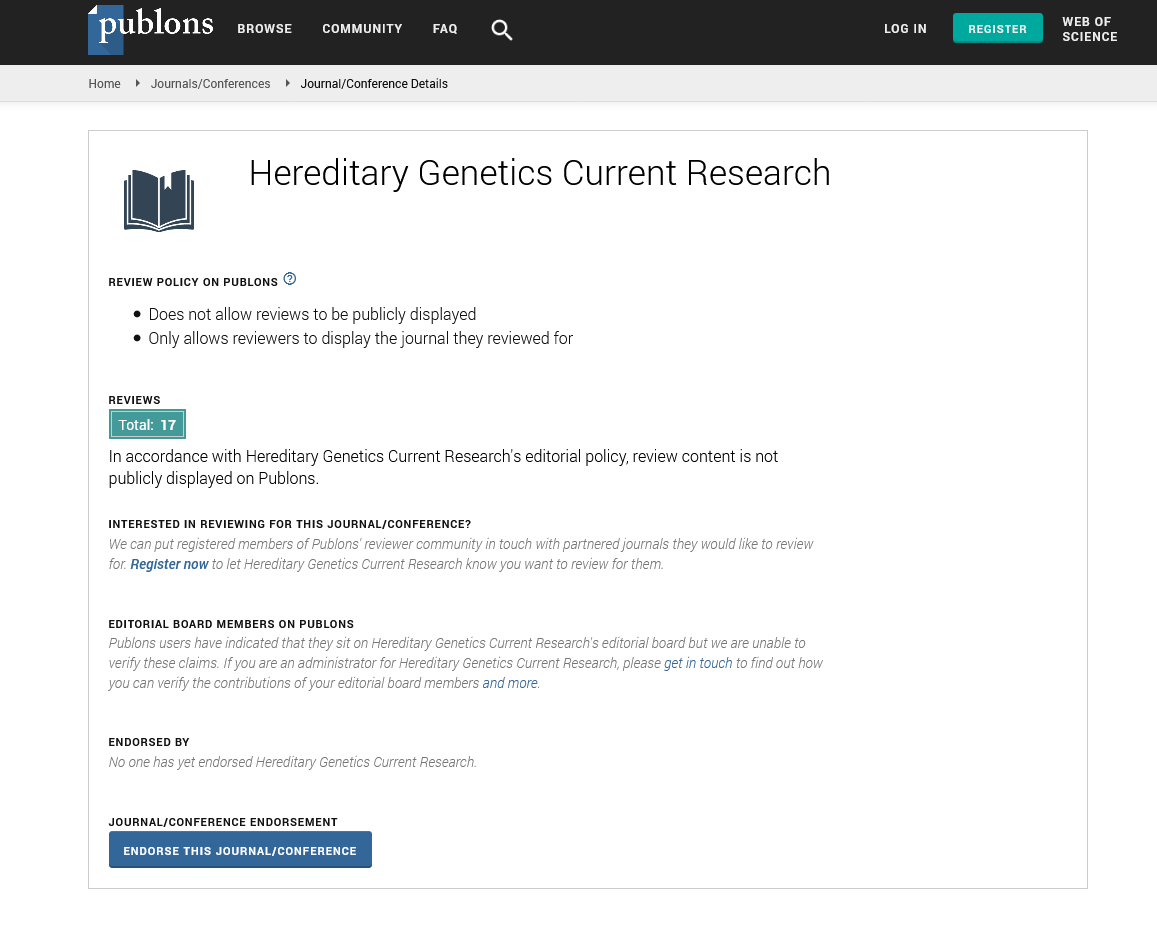PMC/PubMed Indexed Articles
Indexed In
- Open J Gate
- Genamics JournalSeek
- CiteFactor
- RefSeek
- Hamdard University
- EBSCO A-Z
- NSD - Norwegian Centre for Research Data
- OCLC- WorldCat
- Publons
- Geneva Foundation for Medical Education and Research
- Euro Pub
- Google Scholar
Useful Links
Share This Page
Journal Flyer

Open Access Journals
- Agri and Aquaculture
- Biochemistry
- Bioinformatics & Systems Biology
- Business & Management
- Chemistry
- Clinical Sciences
- Engineering
- Food & Nutrition
- General Science
- Genetics & Molecular Biology
- Immunology & Microbiology
- Medical Sciences
- Neuroscience & Psychology
- Nursing & Health Care
- Pharmaceutical Sciences
Perspective - (2023) Volume 12, Issue 3
Spontaneous Mutagenesis and Its impact on Human Evolution
Qiaowen Cheng*Received: 01-Sep-2023, Manuscript No. HGCR-23-23086; Editor assigned: 04-Sep-2023, Pre QC No. HGCR-23-23086 (PQ); Reviewed: 18-Sep-2023, QC No. HGCR-23-23086; Revised: 25-Sep-2023, Manuscript No. HGCR-23-23086 (R); Published: 02-Oct-2023, DOI: 10.35248/2161-1041.23.12.259
Description
Spontaneous mutagenesis is a fundamental process in the evolution of species and the development of diseases, including cancer. In recent years, significant progress has been made in understanding the molecular mechanisms underlying spontaneous mutagenesis. DNA replication is a critical cellular process that ensures the constant transmission of genetic information from one generation of cells to the next. During replication, DNA polymerases synthesize a complementary strand of DNA based on the template provided by the original DNA molecule. These polymerases are remarkably accurate, with error rates estimated to be around one error per billion nucleotides incorporated. However, the absolute volume of DNA replication that occurs in a human cell presents a challenge. With over six billion base pairs in the human genome, each cell must accurately replicate its DNA thousands of times during its lifespan. Even with such low error rates per base pair, this still leads to a significant number of potential mutations due to the absolute magnitude of replication events.
DNA polymerases are the enzymes responsible for DNA replication. They catalyze the addition of nucleotides to the growing DNA strand and ensure the proper base pairing between the template strand and the incoming nucleotide. DNA polymerases have evolved advanced proofreading mechanisms to correct errors that occur during replication. However, these proofreading activities are not accurate and mutations can still arise. These polymerases are responsible for the bulk of DNA replication during cell division. DNA polymerase δ (Pol δ) and DNA polymerase ε (Pol ε) are the primary replicative polymerases in eukaryotic cells. They are known for their high accuracy but can occasionally make errors during replication. In addition to the replicative polymerases, cells also have specialized DNA polymerases that play key roles in various DNA repair processes. One such polymerase is REV1 (also known as REV1-Polymerase ζ), which has unique properties related to Translesion Synthesis (TLS). REV1 is a specialized DNA polymerase that is part of the REV1-Polymerase ζ complex. Unlike replicative polymerases, REV1 is characterized by its ability to insert nucleotides opposite damaged DNA templates. This process, known as Translesion Synthesis (TLS), allows cells to bypass DNA lesions and continue replication. In TLS, when a replicative polymerase encounters a DNA lesion, it stalls. REV1 is recruited to the site of the lesion, and it inserts nucleotides opposite the damaged site. This allows replication to continue past the lesion, even though the inserted nucleotide may not be a counterpart for the template.
REV1-Polymerase ζ is error-prone by design. It lacks the severe proofreading mechanisms of replicative polymerases, which makes it more likely to insert incorrect nucleotides during TLS. This inherent infidelity of REV1 is essential for generating mutations, especially when DNA damage is encountered. While REV1-Polymerase ζ contributes to spontaneous mutagenesis, its activity must be tightly regulated. Too much mutagenesis can be detrimental, leading to genomic instability and diseases like cancer. Therefore, the cell tightly controls the advancing and activity of REV1-Polymerase ζ to strike a balance between error- prone TLS and constant DNA replication.
PRIMPOL (Primase-Polymerase) is another specialized DNA polymerase that plays a critical role in controlling spontaneous mutagenesis. Unlike REV1-Polymerase ζ, which primarily operates during TLS, PRIMPOL is involved in both replication and DNA repair processes. PRIMPOL is named for its primase activity, which allows it to synthesize short RNA primers needed to initiate DNA replication. This primase function is critical for the restart of stalled replication forks.
PRIMPOL also possesses polymerase activity, which enables it to extend the RNA primers it generates during replication restart. Importantly, PRIMPOL is capable of inserting nucleotides opposite damaged DNA templates, similar to REV1. PRIMPOL, like REV1, can introduce mutations during DNA replication and repair. However, PRIMPOL appears to be more accurate in nucleotide selection than REV1. This suggests that PRIMPOL may serve as a "guardian" against excessive mutagenesis by providing a less error-prone alternative to REV1-Polymerase ζ. The balance between mutagenesis and genomic stability is finely regulated in human cells. REV1-Polymerase ζ and PRIMPOL, along with other DNA polymerases, work in concert to maintain this balance. During TLS, REV1-Polymerase ζ is often the first responder to DNA lesions. It inserts nucleotides opposite the damage, but if the lesion is particularly challenging, other polymerases like PRIMPOL may be advanced to complete the synthesis. PRIMPOL's relatively higher accuracy may help correct errors introduced by REV1. Cells tightly regulate the recruitment and activity of both REV1-Polymerase ζ and PRIMPOL. This regulation ensures that these polymerases are only utilized when necessary, preventing excessive mutagenesis. Understanding the roles of REV1-Polymerase ζ and PRIMPOL in spontaneous mutagenesis has significant clinical implications, especially in the context of cancer.
Dysregulation of TLS and the excessive mutagenesis it can promote are associated with cancer development. Targeting the DNA repair pathways involving REV1-Polymerase ζ and PRIMPOL has emerged as a potential therapeutic strategy in cancer treatment. By selectively inhibiting these polymerases, it may be possible to sensitize cancer cells to chemotherapy or the radiation therapy. Understanding the genetic makeup of tumors, including mutations in DNA repair and replication genes like REV1 and PRIMPOL, can guide precision medicine approaches. Modifying treatments based on a tumor's specific mutational profile may lead to more effective therapies.
Conclusion
Spontaneous mutagenesis is a complex and tightly regulated process in human cells. REV1-Polymerase ζ and PRIMPOL are key players in this process, contributing to both genomic stability and mutagenesis. The delicate balance between these two aspects is critical for maintaining the integrity of the genome while allowing for the evolution of species and adaptation to changing environments. Understanding the roles of these polymerases in spontaneous mutagenesis has far-reaching implications, from cancer development to potential therapeutic strategies and precision medicine approaches.
Citation: Cheng Q (2023) Spontaneous Mutagenesis and its Impact on Human Evolution. Hereditary Genet. 12:259.
Copyright: © 2023 Cheng Q. This is an open-access article distributed under the terms of the Creative Commons Attribution License, which permits unrestricted use, distribution and reproduction in any medium, provided the original author and source are credited.

